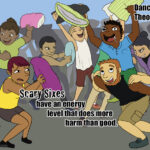Dance Floor Theory is an engagement system that can be used by any team or organization to better engage their employees or members. We use dance floors as a visual representation of engagement within an organization. In the middle of the dance are the most engaged dancers. We call them 5s. The least engaged dancers are on the edge. We call those people Neutrals. In-between the 5s and Neutrals are four additional levels of engagement. The goal of the DFT Engagement System is to move people, one level at a time, towards Level 5.
Since 2004 we’ve trained leaders all over the world on DFT. People often ask us about the following four big ideas. I’d like to address those ideas now to help dispel the myths.
MYTH #1 – Being a 5 means you have to be an extrovert
Yes, on a dance floor, extroverts tend to dominate the center of the dance floor. They feed off of the energy they get from being surrounded by masses of people. And one might then assume that since the Dance Floor Theory Engagement System visually places 5s in the middle and extroverts dominate the middle, that you have to be an extrovert to be a 5. Wrong.
We use dance floors as a metaphor for any group of people. Each DFT Level is based on how engaged someone is within that specific community or team, not how energetically they are dancing. Step off a dance floor and into an organization, like a church, and you’ll still see different levels of engagement. But, no longer is that engagement based on how enthusiastically they are dancing. Those levels represent how engaged they are in the culture of the church.
Both introverts and extroverts can be labeled as DFT Level 5 Leaders. Introverts are actually well known to be very skilled at building relationships. And on the other side, if someone is extroverted and too over the top when engaging with a group of introverts, their energy level might do more harm than good. In Dance Floor Theory, we call this type of person a Scary 6. Scary 6s need to be spoken with to understand that their behavior is damaging before it’s too late. Statistically speaking, introverts make up 33-50% of society. Therefore, letting a Scary 6 run free in your organization could mean serious HR issues or loss of employees.
MYTH #2 – Being a 5 means you have to be in the center
Social comfort with peers is the foundation of engagement and retention of any dance floor. That’s why the first lesson of DFT is that “more friends equals more fun.” It’s just a lot easier to dance with friends than with random people. Gallup research found that when they asked employees if they had a best friend at work, it was correlated with increased levels of engagement at work. Social comfort is extremely important for every level of engagement from Neutral through 4s. But when you move towards Level 5, things change. Your motivation is no longer about your own social comfort, but rather the social comfort of everyone else on the dance floor. A true Level 5 Leader leaves the center and engages with Neutrals, 1s, 2s, 3s, and 4s to build their social comfort.
MYTH #3 — Executives are automatically 5s
An executive asked me to sit in on an internal team meeting of a larger organization to see if I could pinpoint who was causing the team to have such a negative attitude. After ten minutes, it was extremely obvious to me who was the culprit. Still, I kept silent, collecting quotes to better defend my case after the meeting. After the room cleared, just the executive and myself were left. He asked me who I thought created the issue. I pulled out my piece of paper with quotes and read a few out loud:
“This last week was absolutely sh*t. We blew it.”
“I don’t get how there can be so many of us and still not get this right.”
“I feel like I’m the only one thinking on this team.”
The executive’s face turned white as I read the quotes because he recognized them as his own. He was the negative energy.
Higher leadership positions do not automatically grant someone a higher DFT Engagement Level. I’ve met front-line workers who are Level 5 Leaders, and I’ve met CEO’s who were 1s and Neutrals. Engagement, just like true leadership, is earned through actions, not titles.
In fact, having a manager, boss, or leader who’s the negative energy on the team is exponentially more damaging than if it’s someone lower on the organizational chart. Gallup found that 70% of variance in employee engagement is due to their manager. In our trainings, we see over and over again a clear connection between a leader’s willingness to join in on trainings and the overall engagement of the rest of the team. I get agitated when I’m brought in to improve an organizations’ culture and I see the leader sitting in the back of the room not engaging.
“Soldiers watch their leaders.”
-Colin Powell
MYTH #4 – DFT only works if people happily get along
While writing of our Dance Floor Theory book, our team had some epic fights about many issues and topics. Our voices were elevated, our blood pressure was higher, and our faces clearly expressed frustration at each other. During one particular disagreement, I remember smiling while we were in the middle of the debate. I was thinking that it was amazing that I had such a dedicated, passionate team. If they didn’t care, they wouldn’t bother. They cared so much that they wanted to flesh out our ideas in our internal meetings. I knew that because of these conversations, by the time we take this book to print, we’ll be delivering the best quality product to the world.
In his book, The Five Dysfunctions of a Team *, Pat Lencioni says that teams who fear conflict are in trouble. Fear of conflict often leads to a lack of commitment.
“Great teams do not hold back with one another. They are unafraid to air their dirty laundry. They admit their mistakes, their weaknesses, and their concerns without fear of reprisal.”
– Pat Lencioni
When a team engages in heated internal debates, it is a healthy sign of a strong sense of commitment and engagement. You can still like your team and not agree with them.
Throughout years of doing Dance Floor Theory trainings, we’ve found the four myths listed above to be the biggest misconceptions that people have about the theory. Our hope is that you now have a clearer understanding of what DFT is not about. Now, we can spend more time focusing on what it is and how you can use this engagement system within your team.




